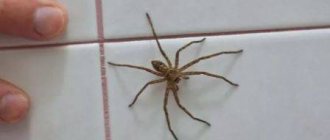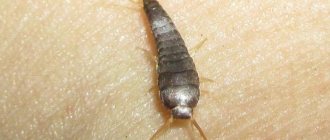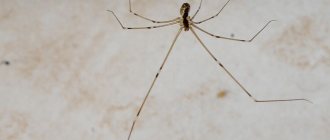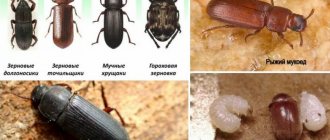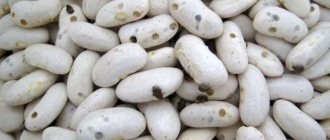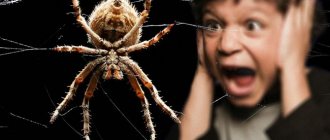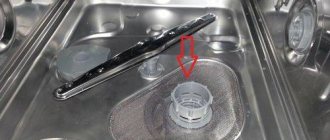Spiders often appear in apartments and houses. Many people are terrified of their “neighbors” and shudder at the appearance of eight-legged arthropods. Sometimes spiders literally fall from the ceiling onto your head or calmly rise on a thin thread in the middle of the room.
Why do spiders appear in the house? Is it good or bad? How to remove unpleasant tenants from the bathroom, room, corridor? There are many solutions and methods. Which spider control method should you choose? The owner of the house must decide. It is important to know what folk superstitions say about spiders.
Why do spiders prefer to live in houses and apartments?
The most suitable conditions for these arthropods are damp, dark, cool places with a lot of insects. The ideal place that matches the description is a cellar or basement. But if there are a lot of spiders in the apartment, then there are reasons for this:
- Dampness. Problems with plumbing or sewerage, leaking faucets and pipes - all this will create favorable conditions for spiders. They live under the bathroom, behind the toilet and pipes;
- Unsanitary conditions. During cleaning, all hanging cobwebs are brushed away from the corners with a broom or sucked up with a vacuum cleaner. When such procedures are carried out regularly, they do not have time to weave a new web for themselves;
- Insects. All animals need to eat. If there are a lot of small pests at home, this will certainly attract unwanted residents.
There are fewer dangers for spiders in houses and apartments than on the street. Therefore, if spiders appear in the house, it means that favorable conditions have been created for them.
Interesting! Spiders easily adapt to living conditions. A few years ago, scientists discovered a new species even in the icy waters of Antarctica.
Favorite Habitats
Spiders in the house prefer to settle in secluded, safe corners.
- Often arthropods can be seen between wooden window frames, under window sills, behind radiators.
- On the balcony, especially if it is used as a place to store necessary and not so necessary things.
- A spider can live in the bathroom - in inaccessible crevices behind pipes and plumbing.
- Dark basements, closets, and attics are the usual habitat of spiders.
- Some spiders prefer to place catching nets on indoor plants or in pots.
Are spiders in the house good or bad?
It is impossible to say unequivocally whether spiders appear in a residential apartment is good or bad. On the one hand, these arthropods bring benefits by destroying dangerous insects. Most of those who live in an apartment do not pose a threat to humans. These are small representatives of their species that feed on midges. They fear us more than we fear them. Larger spiders prefer to weave their webs outdoors, under roofs, and in tree branches. They need more prey than flies, fleas and mosquitoes. Such individuals can wander into living quarters only occasionally.
When they see a person, apartment spiders try to hide. They do not attack or bite.
On the other hand, arachnophobia is one of the most common types of phobias. This disease affects almost 7% of the world's population. According to statistics, spiders are feared more than cars, planes and weapons.
Interesting! Not only people, but also many animals are afraid of these arthropods.
For people who are afraid of spiders, living in the same apartment with them is not comfortable. And if there are many such neighbors, then this will cause inconvenience to anyone.
Are house spiders dangerous for humans?
Black house spiders that live in the middle latitudes of Russia are practically not dangerous to humans and their pets. They do not release poison or other substances that could harm health or cause a reaction in the body.
Large black spiders are dangerous only in Sochi and other cities with warm climates. In Siberia and the Urals they do not pose a danger to people. Their poison can only be fatal to small insects. The sprayed insecticide is not harmful to people.
If, however, a person does not know whether house spiders are dangerous, then you can play it safe by treating the bite site with hydrogen peroxide or alcohol. In addition, alcohol tinctures are suitable for processing.
Description of the species found in the apartment
House spiders number no more than a dozen species. They hide from humans in dark corners and are completely harmless. They can be distinguished by the appearance and structure of the web.
Harvesting spider
Characterized by a small body and long thin legs. It is not poisonous and does not bite. Its web is not sticky. The networks are woven in a sloppy and disorderly manner. The victim, falling into such a trap, simply becomes entangled and cannot get out. It feeds on beetles, mosquitoes, midges, flies and other small insects. Helps regulate the number of pests in the apartment
This is interesting! If a haymaker is grabbed by the leg, he will throw it back to escape. But a new leg will not grow.
Large steatoda
Small arthropod (6-10 mm) black or dark brown. Females are slightly larger. There are characteristic spots on the abdomen. Males are white, females are reddish. Food: small insects. The web is sticky. They hunt at night. Steathode is poisonous. However, the poison of one individual is not enough to seriously harm a person. Still, if you are bitten, you should go to the hospital.
Amarobiid spider
You can hardly find amarobiids in residential premises. More often he lives in basements and on balconies. Its network has a funnel-shaped structure. The web is not sticky. It feeds on beetles and insects. When the victim gets caught in the web, it jumps out and drags him into the shelter. Amarobiids are red in color and reach 8-15 mm in size. It does not attack itself, but in defense it can bite.
Phalangoid folkus
A fairly common long-legged house spider. Small translucent body, brown-gray long legs. They eat insects and their own kind. Poisonous. But their poison is not dangerous for humans. There may be a slight burning sensation at the site of the bite.
Attic spider
Quite a large representative of house spiders (body 12 - 18 mm long). The color is dark brown. The sternum has a lighter marking with three spots on each side. Legs are hairy. The male and female are practically no different in appearance. Poisonous, but not dangerous to humans and domestic animals. Not aggressive. It can bite only in self-defense. The net is not sticky. It waits until the victim falls into the web, jumps out and attacks it.
House spider
The house spider has an elongated body. The color of an adult varies from dark orange to brown or beige. Legs are striped. There are two dull black stripes on the cephalothorax. The abdomen is motley - brown, beige and gray. Hunts at night for flies and mosquitoes.
The house spider weaves webs with a funnel. The threads from the web spread out to different corners of the room. When another insect gets caught in the net, it jumps out and is pulled into the funnel, where it is eaten. Not an aggressive species. If the web is not broken, it hides in it, and if it is damaged, it runs away. In case of danger, it can bite, but the bite is painless for humans.
Hobo spider
The tramp differs from its relatives in that it does not weave a web. He constantly wanders from place to place. When a tramp sees a victim, he quickly attacks it and injects it with poison, and then eats it. This species is small in size - less than a centimeter in length. The back is brown, with black and light spots. The venom of this arthropod is not dangerous to humans.
Spider Body Size and Structure
The body size of an animal depends on its gender. An adult female grows up to twelve millimeters in length, a male up to eight millimeters. Taking into account the distance between the legs, this size increases to twenty millimeters.
Tarantula spider on a man's hand
A characteristic feature of this species is the brown marking that resembles a violin. It appears in mature individuals, but is sometimes noted in young spiders. The recluse spider has six eyes, unlike other arthropod species that have eight visual organs.
At rest, the animal’s paws, devoid of spines, are thin and long, evenly distributed on the sides. In case of danger, the front legs are pulled under the body, the side legs are raised, and the hind legs are straightened.
The paws and lower part of the body are uniformly colored, without spots or stripes. On the bends of the joints of the legs, pigmentation is lighter compared to the main one. The color of the animal's body depends on its habitat and environmental conditions, from brown and dark brown to completely black.
The abdominal cavity of the hermit beetle is covered with fine hairs that look like fur when viewed under a microscope.
Routes of entry into human habitation
There are several options for where spiders come from in your home:
- with air currents. The barely hatched spiders, along with the air, enter the apartment through an open window or door;
- on a person or animal. A new neighbor can be brought into the house on clothes, shoes, hair or animal fur;
- cracks. A very small gap in the walls, floor or ceiling is enough;
- ventilation and chimney.
Prevention
Important points:
- The basic rules are cleanliness in the house plus no food. If there are no bedbugs, cockroaches, flies, midges, small bugs, or ants in the home, then the spiders have nothing to eat; they go to other rooms in search of small insects.
- Another important rule is cleanliness control. In a bright, spacious, uncluttered home, with timely elimination of leaks, cleaning up crumbs on the floor, and the absence of dark corners where eight-legged creatures and various insects love to hide, hordes of spiders are unlikely to appear. Dust, debris particles, mountains of trash are factors that influence the reproduction of cockroaches, midges, flies, and mosquitoes, which are food for spiders.
- Mosquito nets must be intact and fit tightly to the frames: insects can easily penetrate even through small cracks.
- If there are a lot of trees near the house, then you need to be more careful, regularly remove cobwebs near the windows, turn on the light in the evening only with the mosquito net closed, if the structure is hinged.
- It is important to monitor the condition of window units: situations occur when a plastic window does not close, does not fit tightly to the frame, or scratches surfaces. If the performance characteristics are violated, cracks appear and the mosquito net is damaged, which makes it easier for flying and crawling insects to enter the home.
READ ALSO: Fruit or fruit midges: how to get rid of insects and prevent their reappearance
Should you be afraid of spiders?
All spiders are predators. The exception is the jumping spider, which feeds on acacia greens. Many of these pests are poisonous. But only a few species out of more than 40,000 are dangerous to humans. They live mainly in Australia and America. The most poisonous and deadly is the “black widow”.
In our region you can find only one poisonous spider - karakurt . You can recognize it by its bright red spots on its black body. The bite is accompanied by sharp pain. To avoid sad consequences, you should immediately consult a doctor.
Other species cannot harm humans. Their bites are no worse for people than the common wasp. And house spiders won’t cause any harm at all. For many, the mere sight of these creatures is unpleasant, while others keep them as pets and sincerely admire the beauty of these creatures.
If you are bitten by a spider unknown to you, you should immediately go to the hospital. First aid for spider bites.
Classification and habitat
There are three types of house recluse spiders:
- brown;
- black;
- brown.
This arthropod is found on three continents, including:
- Africa;
- North and South America.
- The Mediterranean variety of spiders, which are harmless to humans, are found in Europe. Other species are rare and occasionally enter areas or vehicles. The hermit spider in Russia is widespread in the middle and southern latitudes; in the north they live in human houses and utility rooms.
A little about folk signs
There are many folk signs associated with these insects. Since ancient times, people have monitored house spiders and, based on their behavior, predicted important events that awaited the family.
Here are a few of them:
- if the spider crawls down, expect problems. It is much better if it creeps up - this is a profit;
- seeing a spider in the morning promises bad news; in the evening, on the contrary, it promises good luck;
- A large number of cobwebs under the bed for unmarried people promises new love acquaintances. A married couple needs to be more attentive to each other’s desires;
- if he crawls over money, expect unexpected financial income;
- The luckiest spider is white. Black is considered a bad omen and brings bad luck.
Not everyone now believes in omens, but there is one that even scientists agree on - you can’t kill spiders! And not because it will bring failure into your life. They are simply an integral part of the ecosystem. Small domestic arthropods are not dangerous to humans. At the same time, they catch harmful and bothersome insects such as mosquitoes and flies.
Advice! If you still want to get rid of the spider, you can simply take it outside.
Is it necessary to exterminate arthropods?
Corners, windows and ceilings covered with cobwebs look untidy. If there are a lot of spiders in the house, it means that the cleaning there is carried out poorly, with hard-to-reach places being ignored. That is why the answer to the question of whether it is necessary to look for a remedy for spiders is in the affirmative. It is possible and necessary to fight arthropods, but it is better to do it humanely, especially if the goal is not to harm living beings.
The most humane method is to remove the spider from the house mechanically. Arthropods are manually collected in a jar or on a scoop, taken away from the house, and the cleanliness of the house is monitored, preventing their further appearance.
Spiders hibernate outdoors under leaves, in warm corners behind the bark of trees, so you can release them from your home at any time of the year.
How to get rid of arthropods?
If you notice only one spider, you can carefully take it outside. The house spider is not capable of causing harm to humans. But what to do if there are a lot of spiders, and this has become a problem? In this case, both chemistry and folk remedies will help in the fight against them.
5 ways to permanently get rid of spiders in an apartment and private house
Chemicals
The chemical industry is represented by a huge variety of all kinds of means to combat unpleasant residents. These include sprays, solutions, and traps.
The most popular drugs are the following:
Butox-50
One of the most popular means for combating arachnids. When working with the drug, you should wear gloves and a mask. Close windows and doors tightly. Butox-50 quickly causes paralysis and death of spiders.
How to use:
- For 10 liters of cool tap water – 30 ml of the drug. This amount will be enough to treat a room of 100 square meters.
- Treat the room.
- Leave the room for 20-30 minutes. After this time, ventilate the room and carry out wet cleaning.
Spray Raid
The chemical industry does not stand still. More and more new means are appearing. Sprays occupy a leading position in this series. The most popular is Raid. The instructions are quite simple - close the windows and doors, spray the spray on the spiders and in their habitats at a distance of 20 centimeters. You need to work in a mask, gloves and protective clothing. After cleaning the area, wash your hands and leave. After a while, ventilate the home well.
Dobrokhim FOS
This product is used to combat all types of insects, spiders and ticks. The drug causes paralysis and rapid death.
Instructions:
- For one liter of water - 10 milliliters of the drug.
- Spray in dark corners, under bathtubs, on windows and ceilings. It’s good if the product gets directly on the spider.
- Leave the windows open and leave the apartment for at least a day.
- Upon return, carry out wet cleaning.
Aquafumigators
According to the manufacturer, aquafumigators have a number of advantages over other means: they are easy to use, kill not only spiders, but also all types of flying and crawling insects even in the most hidden places, the active substance is distributed through steam.
How to use:
- Remove the metal container from the packaging.
- Pour the water from the bag into a plastic container.
- Place the container in a container of water.
- The action will begin in a couple of minutes.
- Close windows and doors tightly and leave for 10-12 hours.
One fumigator weighing 10 grams is enough to treat a room of 30 square meters.
Trap tablets
This product does not emit an unpleasant odor and does not require leaving the room for several hours. All you have to do is place traps around the apartment and wait. The tablets emit a smell that attracts spiders. They fall into a trap and receive a lethal dose of poison.
Folk recipes
Before using chemistry, you can try several folk recipes. Spiders cannot tolerate strong odors. Specific aromas can make them leave their home for a long time.
Here are a number of simple and effective tricks:
- Grind chestnuts into powder and scatter them in corners, under the bathtub, in arthropod habitats
- Dilute 15 drops of mint, eucalyptus or tea tree essential oil in a liter of water. Treat all corners, dark places, window sills, pipes.
- An indispensable assistant in the fight against spiders is vinegar. Mix this substance and water in a 1:1 ratio in a container and treat all places where arthropods can hide.
- They also cannot stand the smell of lemon and maclura. To make unwanted neighbors leave the house, you can cut these fruits and place them near the web.
There are many means to combat spiders. Everyone can choose the one that suits them. But to prevent spiders from returning, we must not forget about prevention.
Benefit or harm
Spiders help fight harmful insects in the house, but at the same time, they create grounds for fear and irritability among household members at the sight of multi-legged creatures scurrying around. Cobwebs in corners and on walls, behind cabinets, under bathrooms and in hard-to-reach places create soil for dust to settle, the remains of eaten insects accumulate, and an unpleasant odor appears.
On the one hand, spiders are housekeepers in the presence of a large number of synanthropic and parasitic insects, but pests must be combated not by breeding arthropods, but by keeping the house clean and tidy, and the absence of favorable conditions for the habitat of any arachnids and mites. Spiders should live away from humans - this principle must be followed.
On a note! Despite the fact that harmless, non-poisonous spiders most often weave webs in apartments and private houses, dangerous specimens are also occasionally found. In addition, fear and severe stress are guaranteed to almost everyone who sees a large spider on the wall or on a thin “fishing line” in the middle of the room right before their eyes. When living in a house with hypertension, patients with nervous disorders, cardiovascular diseases, or impressionable individuals, it is necessary to restore order even more actively in order to avoid encounters with insects that terrify many people.
Preventive measures
You can prevent and prevent the mass appearance of spiders in your apartment using prevention:
- fix plumbing and pipes. The house should be dry;
- seal all cracks and holes in the walls, windows, floor and ceiling;
- carry out regular cleaning. In a clean house, not only will there be no cobwebs, but also other insects that attract spiders.
It is impossible to completely protect yourself from spiders. Sooner or later they will appear in the apartment again. But if preventive measures are taken, they will not last long.
Spiders are an unpleasant neighborhood for many people, but they are part of the ecosystem and do not pose a danger to humans. Regular wet cleaning and control of harmful insects at home will be the best protection for your home from spiders.
Reasons for appearance
Spiders settle where there is food. If the home is perfectly clean and there are no small insects to hunt, then spiders are unlikely to settle in the home. Some individuals can climb into an apartment from a nearby tree or through a choke, but in the absence of favorable conditions, if there is no food in the room, spiders do not stay for long and crawl into neighboring dwellings.
The risk of colonization by eight-legged arthropods increases in the presence of factors:
the housewife rarely cleans the house; a lot of dust and debris accumulate in secluded places; there are dark areas where it is easy to create cobwebs; food for spiders lives in the home: cockroaches (Prussians), red house ants, flies, beetles, midges; unsanitary conditions, clutter combined with a lack of sunlight and infrequent treatment of hard-to-reach places; the gaps between the front door and the staircase are poorly sealed, there are access areas through air vents, torn mosquito nets, cracks in the floor and walls, near sewer pipes, through cracked balcony frames and wooden doors; the owners did not install mosquito nets on the windows or the structure is worn out, there are holes and torn areas; in the dark, when the lights in the apartment are turned on, spiders easily sneak into the home. Until the situation with the protective net is corrected, it is advisable not to light a light bulb in the room or close the windows in the evening: not only spiders, but also mosquitoes, midges, moths, and butterflies penetrate into a lit home.
If spiders are actively breeding in your home, you need to find a source of food: probably the household and the housewife see synanthropic insects living in the home. Haven't been able to detect the obvious presence of pests yet? You will have to examine all the nooks and crannies, the area under the bathroom, disassemble the pantry, check the areas behind the baseboards, under the refrigerator, above the mezzanines: one of the listed places is sure to be home to parasites and “uninvited guests.” Even clothes or fur moths in the closet are a food source for spiders.
Arthropod feeding and web placement
Inside the arachnid's body there are special arachnid glands that produce a sticky liquid. With its help, the insect weaves its web. The strength of the threads is achieved by releasing different amounts of the composition from different glands.
The web is used for the following purposes:
- catching insects;
- flights;
- hiding a clutch of eggs.
This species of arthropod is a toothless predator. They do not catch prey on the fly. The spider attaches itself to the web and waits for the food to fall into its web. The insect begins to twitch, trying to escape. The web oscillates, notifying the hunter that dinner is served.
The predator attacks the prey and injects poison into it, while entangling it with threads. After some time, the insecticide dissolves the insect, and the spider can suck out the nutritional fluid.
Web for catching prey.
